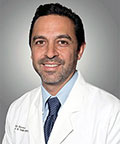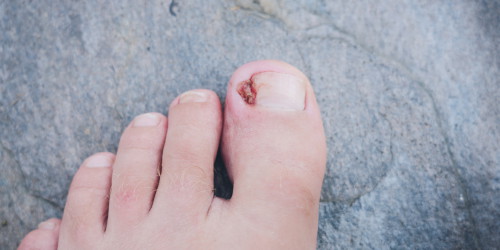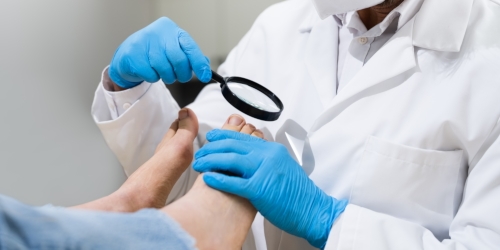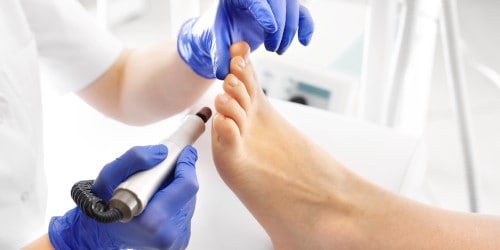- Home
- Foot & Ankle Conditions
- Toenails Conditions
- Ingrown Toenail
ingrown Toenail: causes, symptoms and treatment
- Published 8/31/2018
- Last Reviewed 3/26/2024
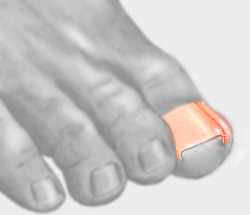
What's an Ingrown Toenail?
An ingrown toenail (also called onychocryptosis) is a common foot problem that involves the nail curving down into the surrounding skin as it grows.
Once the edge of the nail breaks through the skin, it can produce inflammation and discomfort. Left untreated, an ingrown toenail may lead to infection, bone disorder, or a recurring problem.
- What are the common causes of an ingrown toenail?
- What are conservative treatment options for an ingrown toenail?
- What are ingrown toenail surgical treatment options?
- What is ingrown toenail surgery recovery like?
- The connection between ingrown toenails and paronychia
- University Foot and Ankle Institute, your best treatment choice for all toenail conditions
- Frequently Asked Questions about Ingrown Toenails and Toenail Removal
- How long does ingrown toenail surgery take?
- Is toenail removal generally covered by insurance?
- Can I wear shoes after ingrown toenail removal surgery?
-
ABFAS® Board Certified in Foot Surgery and Reconstructive Rearfoot and Ankle Surgery. and Director of University Foot and Ankle Institute
Dr. Bob Baravarian DPM, FACFAS is a Board-Certified Podiatric Foot and Ankle Specialist. He is an assistant clinical professor at the UCLA School of Medicine and serves as Director of University Foot and Ankle Institute.
Dr. Baravarian has been involved in athletics his entire life and played competitive tennis in high school and college. He has an interest in sports medicine, arthritis therapy, and trauma/reconstructive surgery of the foot and ankle. He is also fluent in five languages (English, French, Spanish, Farsi, and Hebrew),
-
ABFAS® Board Certified in Foot Surgery and Reconstructive Rearfoot and Ankle Surgery. and Director of University Foot and Ankle Institute
Dr. Bob Baravarian DPM, FACFAS is a Board-Certified Podiatric Foot and Ankle Specialist. He is an assistant clinical professor at the UCLA School of Medicine and serves as Director of University Foot and Ankle Institute.
Dr. Baravarian has been involved in athletics his entire life and played competitive tennis in high school and college. He has an interest in sports medicine, arthritis therapy, and trauma/reconstructive surgery of the foot and ankle. He is also fluent in five languages (English, French, Spanish, Farsi, and Hebrew),
Learn More from our Ingrown Toenail Blog Articles
 I've been coming to Dr. Briskin ever since my son was in elementary school (he's now 29). I don't think there's a better podiat...Tina C.
I've been coming to Dr. Briskin ever since my son was in elementary school (he's now 29). I don't think there's a better podiat...Tina C. Please provide handicap parkingBarry S.
Please provide handicap parkingBarry S. Dr. Ambibola Johnson is awesome!Laurie S.
Dr. Ambibola Johnson is awesome!Laurie S. I appreciate the care and timeliness of all my appointments I’ve had at UFAI. Gray, Lydia and the staff all are wonderful. Lydi...Edelmira G.
I appreciate the care and timeliness of all my appointments I’ve had at UFAI. Gray, Lydia and the staff all are wonderful. Lydi...Edelmira G. Very greatfull for the doctor and stuffJesus M.
Very greatfull for the doctor and stuffJesus M. Very impressed with the knowledge, professionalism and care from Dr. Johnston. He knew exactly what my issues were and helped ...Laurie S.
Very impressed with the knowledge, professionalism and care from Dr. Johnston. He knew exactly what my issues were and helped ...Laurie S. Doctor was very caringBrigitte S.
Doctor was very caringBrigitte S. Everyone is very nice and efficient-
Everyone is very nice and efficient-
Especially Dr Kelman. He takes very good care of me!!Claudia K. Great costumer service.
Great costumer service.
Prompt and efficientDean W. No . I’m pleased with the care .Michael P.
No . I’m pleased with the care .Michael P. Appreciate the professionalism and expertise, as well as the caring.Stella G.
Appreciate the professionalism and expertise, as well as the caring.Stella G. I absolutely love everyone in this office. Maria is adorable. Sylvia is so nice and accommodating. Michelle is so patient with ...Joan A.
I absolutely love everyone in this office. Maria is adorable. Sylvia is so nice and accommodating. Michelle is so patient with ...Joan A.

